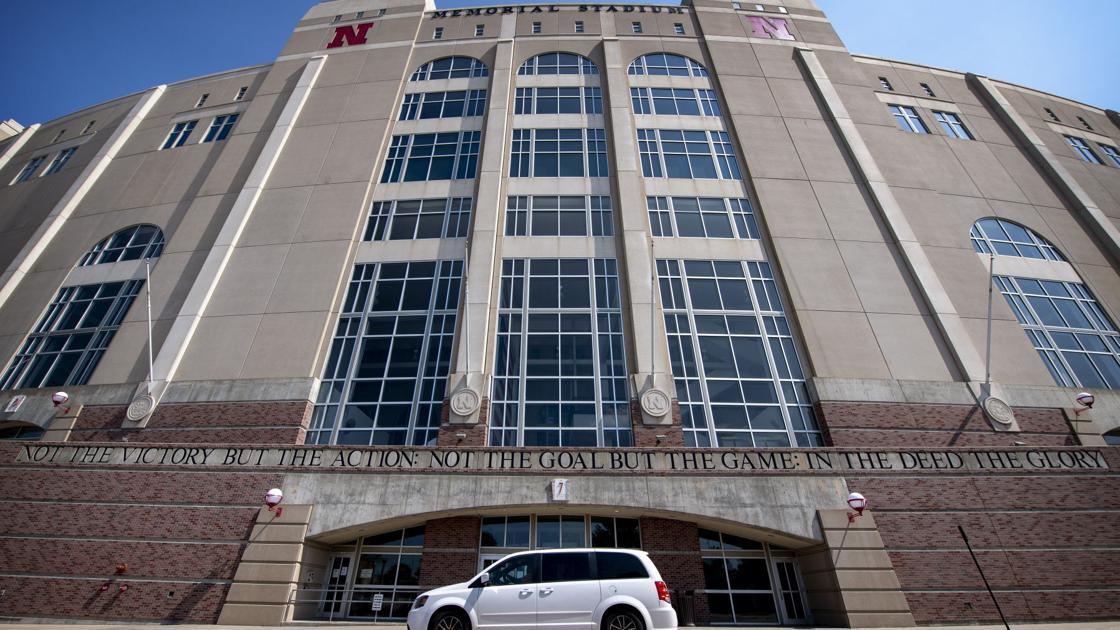
If Memorial Stadium looks like it does here, Sept. 5, 2020, on football gamedays this fall, several schools, including Nebraska, will face “some real, real problems,” according to NU athletic director Bill Moos.
FRANCIS GARDLER, Journal Star file photo
The impact of the coronavirus pandemic on college athletics is still being felt every time fans check in on their favorite teams.
Flip on a college basketball game Friday evening, and there’s the Nebraska men’s team trying to upset No. 6 Illinois at home in front of an empty arena rather than a roiling Pinnacle Bank Arena crowd. Not 12 hours after the Huskers fell short in overtime, they were on a plane to Pennsylvania to continue a torrid stretch of makeup games — seven games in 11 days — after a three-week layoff because of a COVID-19 outbreak.
The softball team just got its modified, 44-game Big Ten schedule. The baseball team still doesn’t have a formal slate despite the fact that some conferences open play next weekend and the Big Ten may do the same just three weeks from now.
John Cook’s volleyball program looks familiar in the sense that the Huskers are 6-0 and ranked No. 4 in the country, but nothing else about it so far is normal.
As winter sports trudge through and spring sports prepare for competition to begin, the one-year anniversary of the NCAA halting both seasons — one on the brink of finishing and the next just getting going — draws close.
All this time later, we understand a lot more about the financial fallout on NU’s athletic department, but can’t say for sure how much more risk remains ahead.
Nebraska athletic director Bill Moos said Friday that his department is projecting a total budget hole of about $42 million for fiscal 2021, which runs through June 30.
“I’m feeling that we’ve been able to mitigate, through some pretty tough decisions and a pretty good television payday,” Moos said Friday. “I said if we didn’t have a (football) season at all it would be about $100 million, and that number is going to be right in the low $40s now.
“We’re kind of hanging our hat right at $42 million.”
Nebraska is dipping into its reserve with the Husker Athletic Fund to plug that gap and ensure that the department can pay its employees — it brought all of its furloughed workers back effective Jan. 1 and ended the mandatory salary reductions — even though nobody knows exactly what effect the pandemic will continue to have through the summer or into the fall.
“We can’t go back to that reserve many times,” Moos said. “Our ability to reach into it for the $42 million, the cookie jar may be empty — not totally, but I’m not sure there’s going to be $42 million in there again. For some of our brethren in the Big Ten, that cookie jar is empty or was empty before they stuck their hand in there.”

Nebraska athletic director Bill Moos says “there’s some real, real problems” for a lot of schools, including Nebraska, if fans are not allowed at football games this fall. This past season, cardboard cutouts filled some of the seats, shown here on Nov. 14, 2020.
FRANCIS GARDLER, Journal Star file photo
Whether Nebraska is faced with revisiting the cookie jar — and to what extent — largely will be determined by what football season looks like this fall. If it goes mostly as planned and fans are back in Memorial Stadium (even if it’s not at 100% capacity) the light at the end of the tunnel will get brighter and brighter.
If not, dark times in college athletics will follow.
“We’re all hopeful that we can have 100% capacity for this next fall and it’s obviously going to depend on where the pandemic is at that time,” Moos said. “We look at our budgets with max capacity, 75%, 50%, 25% and 0%. …
“If we’re back with empty stadiums next year, there’s some real, real problems for a lot of schools and that does not exclude Nebraska.”
The Big Ten Conference has the final say over fans being allowed at its competitions — Moos said he and other schools continue to push for more localized decision-making control for campuses and local health departments — and it is of course impossible to accurately say what the pandemic will look like in August.
Empty stadiums seem unlikely at this point, but football season drives such a large slice of the revenue pot at schools like Nebraska, that those fall Saturdays are never far from the minds of administrators like Moos.
“We have done a good job and our coaches have been fabulous on watching our expenses, realizing that we all have to come together to attack this thing and to get through it, so they’ve made sacrifices and they’ve been wonderful and they’ve been there for each other,” he said. “The best thing that can happen at the end of the day is to get football healthy on the revenue side. Then every sport can realize some help there.
“Though they all know the importance of football and men’s basketball as a revenue source, they are fully aware of it now because it’s affected all of them.”
Up until March, the money machine was humming along.
Nebraska generated $133.6 million in fiscal 2020 despite the pandemic scrambling the final 3½ months of the budget year, according to a copy of the school’s annual financial report obtained via records request by the Journal Star. Had the NCAA not been forced to cancel when it did, NU likely would have pushed toward or beyond its record $136.2 million revenue record from the previous year.
However, the cancellation of the Big Ten and NCAA men’s basketball tournaments resulted in the payouts from those events dropping by more than $1.8 million year-over-year. Also, the baseball program saw its ticket revenue fall by more than $500,000 year-over-year because Will Bolt’s team played only six home games before the remainder of the season was canceled.
Before the pandemic, the football program set a revenue record in fiscal 2020, generating $97.5 million in revenue and turning a record $64.2 million profit. The athletic department finished in the black by $13 million overall and again turned over some $10 million to the university ($5 million to be used “at the chancellor’s discretion” and $5 million in nonathletic scholarships).
Of course, the financial picture looks entirely different now.
Moos in December said the department was projecting somewhere in the neighborhood of $60 million in revenue for fiscal 2021. That would have been far worse had the eight-game football season and modified basketball season not provided a significant television inventory that will result in a per-school payout of somewhere near $40-42 million — a drop of more than $12 million from past years but still a significant number.
NU implemented a 10% cut across sports budgets and in the salaries of its highest-paid employees last summer, eliminated 17 full-time positions and furloughed 51 employees for four months. In total, NU trimmed somewhere in the neighborhood of $30 million in expenses for fiscal 2021, according to Moos. It also incurred new expenses, including more than $500,000 in COVID-19 testing (in addition to $4 million paid by the Big Ten) since the summer.
Last year, NU finished with $120.6 million in expenses, though they undoubtedly were tracking to be higher before March, perhaps toward the previous-year number of $124.6 million.
Using the 2021 financial report and Moos’ estimations for fiscal 2021, the rough estimate would be for revenues and expenses to fall from $133.6 and $120.6 in fiscal 2020, respectively, to something like around $60 million and around $102 million in fiscal 2021.
All in all, Nebraska’s athletic department is able to lean on its reserve at the foundation to cover the projected $42-million hole in its budget caused by the pandemic to date.
The question is what happens from here.
College sports fans will be happy if they’re able to binge-watch NCAA Tournament games next month, a spring rite of passage that was taken away last year. Maybe Cook and the Huskers will make a run toward a national title in a modified tournament to be held in Omaha. Maybe NU fans will even be able to get to Bowlin Stadium and Haymarket Park to watch Husker softball and baseball later this spring.
The glimmers have a chance to start shining through soon. A return to normalcy, though? For the overall health of NU athletics and the department’s financial picture, that will be an open question until the fall.
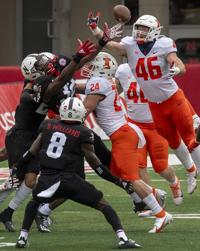
Illinois’ Alec McEachern (46) and Nebraska’s Niko Cooper (32) reach for a fumble on a kickoff return in the second quarter Nov. 21, 2020, at Memorial Stadium.
FRANCIS GARDLER, Journal Star file photo
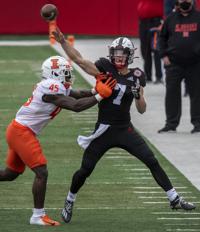
Nebraska quarterback Luke McCaffrey (7) throws an interception under pressure from Illinois’ Khalan Tolson (45) in the first quarter Nov. 21, 2020, at Memorial Stadium.
FRANCIS GARDLER, Journal Star file photo
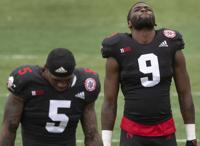
Nebraska safety Marquel Dismuke (9) and Cam Taylor-Britt (5) walk off the field after the Huskers’ 41-23 loss to Illinois on Nov. 21, 2020, at Memorial Stadium.
FRANCIS GARDLER, Journal Star file photo

Nebraska quarterback Luke McCaffrey gets his helmet twisted around by Illinois’ Roderick Perry (96) in the second half Nov. 21, 2020, at Memorial Stadium.
FRANCIS GARDLER, Journal Star file photo

Nebraska quarterback Adrian Martinez (2) is lifted up by teammate Bryce Benhart after scoring a touchdown in the second quarter against Iowa on Nov. 27, 2020, at Kinnick Stadium in Iowa City, Iowa.
FRANCIS GARDLER, Journal Star file photo

Nebraska coach Scott Frost leads the Huskers onto the field to take on Iowa on Nov. 27, 2020, at Kinnick Stadium in Iowa City, Iowa.
FRANCIS GARDLER, Journal Star file photo

Nebraska cornerback Dicaprio Bootle (7) celebrates his second-quarter interception with teammate Cam Taylor-Britt against Iowa on Nov. 27, 2020, at Kinnick Stadium in Iowa City, Iowa.
FRANCIS GARDLER, Journal Star file photo

Iowa’s Terry Roberts (22) dives on a fumbled punt return by Nebraska’s Cam Taylor-Britt (5) in the fourth quarter Nov. 27, 2020, at Kinnick Stadium in Iowa City, Iowa.
FRANCIS GARDLER, Journal Star file photo

Iowa quarterback Spencer Petras gets off a third-quarter pass as Nebraska’s Garrett Nelson (44) and Luke Reimer (28) pressure him Nov. 27, 2020, at Kinnick Stadium in Iowa City, Iowa.
FRANCIS GARDLER, Journal Star file photo

Nebraska’s Wan’Dale Robinson rushes against Iowa’s Jack Campbell (31) in the second half Nov. 27, 2020, at Kinnick Stadium in Iowa City, Iowa.
FRANCIS GARDLER, Journal Star file photo

Nebraska quarterback Adrian Martinez reaches for the high snap in the first quarter against Iowa on Nov. 27, 2020, at Kinnick Stadium in Iowa City, Iowa.
FRANCIS GARDLER, Journal Star file photo

Nebraska coach Scott Frost leads the Huskers out to the field against Iowa on Nov. 27, 2020, at Kinnick Stadium in Iowa City, Iowa.
FRANCIS GARDLER, Journal Star file photo

Nebraska quarterback Adrian Martinez throws under pressure from Iowa’s Joe Evans (13) in the second quarter Nov. 27, 2020, at Kinnick Stadium in Iowa City, Iowa.
FRANCIS GARDLER, Journal Star file photo

Nebraska quarterback Adrian Martinez and the Husker offensive line push toward the goal line on Martinez’s 1-yard touchdown run against Iowa on Nov. 27, 2020, at Kinnick Stadium in Iowa City, Iowa.
FRANCIS GARDLER, Journal Star file photo

Nebraska coach Scott Frost talks with his players during a first-half timeout against Iowa on Nov. 27, 2020, at Kinnick Stadium in Iowa City, Iowa.
FRANCIS GARDLER, JOURNAL STAR FILE PHOTO

Penn State quarterback Will Levis (7) gets pressured by Nebraska’s Ben Stille on a fourth-down play, throwing an incomplete pass to turn it over to the Huskers in the final moments of the game Nov. 14, 2020, at Memorial Stadium.
FRANCIS GARDLER, Journal Star file photo

Luke McCaffrey (7) and Wan’Dale Robinson (1) celebrate after the Huskers’ win over Penn State on Nov. 14, 2020, at Memorial Stadium.
FRANCIS GARDLER, Journal Star file photo

Nebraska safety Deontai Williams (8) strips the ball from Penn State quarterback Sean Clifford. Williams recovered the fumble and returned it for a touchdown in the second quarter Nov. 14, 2020, at Memorial Stadium.
FRANCIS GARDLER, Journal Star

Nebraska safety Deontai Williams (8) strips the ball from Penn State quarterback Sean Clifford before recovering the fumble and returning it for a touchdown in the second quarter Nov. 14, 2020, at Memorial Stadium.
FRANCIS GARDLER, Journal Star file photo

Nebraska’s Collin Miller (31) celebrates after Ben Stille (right) tackled Penn State quarterback Will Levis (left) to give the Huskers the ball on downs in the fourth quarter Nov. 14, 2020, at Memorial Stadium.
FRANCIS GARDLER, Journal Star file photo

Nebraska’s Ben Stille (95) and Ty Robinson walk off the field after the Huskers’ 30-23 win over Penn State on Nov. 14, 2020, at Memorial Stadium.
FRANCIS GARDLER, Journal Star file photo

Nebraska kicker Connor Culp sends a ball through the uprights for a fourth-quarter field goal against Penn State on Nov. 14, 2020, at Memorial Stadium.
FRANCIS GARDLER, Journal Star

Nebraska’s Will Honas (3) tackles Penn State’s Pat Freiermuth (87) in the fourth quarter on Nov. 14, 2020, at Memorial Stadium.
FRANCIS GARDLER, Journal Star file photo

Nebraska head coach Scott Frost instructs the team during a timeout on Nov. 14, 2020, against Penn State at Memorial Stadium.
FRANCIS GARDLER, Journal Star

Nebraska quarterback Luke McCaffrey (7) gets the snap from center Cameron Jurgens (51) as running back Ronald Thompkins (25) and Ethan Piper look to block against Penn State on Nov. 14, 2020, at Memorial Stadium.
FRANCIS GARDLER, Journal Star file photo

Nebraska’s Cam Taylor-Britt (5) runs back a punt as he avoids the tackle of Penn State’s Daequan Hardy in the first half Nov. 14, 2020, at Memorial Stadium.
FRANCIS GARDLER, Journal Star file photo

Nebraska safety Deontai Williams (8) strips the ball from Penn State quarterback Sean Clifford in the second quarter Nov. 14, 2020, at Memorial Stadium. Williams recovered the fumble and scored.
FRANCIS GARDLER, Journal Star file photo

Nebraska’s Noa Pola-Gates (facing) hugs senior Marquel Dismuke (9) after the Huskers’ 24-17 loss to Minnesota on Dec. 12, 2020, at Memorial Stadium.
FRANCIS GARDLER, Journal Star file photo
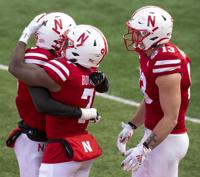
Nebraska senior Dicaprio Bootle (7) hugs fellow senior Marquel Dismuke (left) as JoJo Domann looks on after the Huskers’ 24-17 loss to Minnesota on Dec. 12, 2020, at Memorial Stadium.
FRANCIS GARDLER, Journal Star file photo

A third-quarter pass from Nebraska quarterback Adrian Martinez (2) is batted by Minnesota’s Rashad Cheney on Dec. 12, 2020, at Memorial Stadium.
FRANCIS GARDLER, Journal Star file photo

Protected by the offensive line, Nebraska quarterback Adrian Martinez (2) has the time to throw in the second quarter against Minnesota on Dec. 12, 2020, at Memorial Stadium.
FRANCIS GARDLER, Journal Star

Husker fan cutouts fill the North Stadium stands before the team takes on Penn State on Nov. 14, 2020, at Memorial Stadium.
FRANCIS GARDLER, Journal Star file photo

Nebraska head coach Scott Frost leads the Huskers out onto a nearly empty stadium before taking on Penn State on Nov. 14, 2020, at Memorial Stadium.
FRANCIS GARDLER, Journal Star file photo

Nebraska’s Cam Taylor-Britt (left) defends a pass intended for Penn State’s Jahan Dotson in the fourth quarter on Nov. 14, 2020, at Memorial Stadium.
FRANCIS GARDLER, Journal Star file photo

Nebraska’s Collin Miller (31) celebrates after Ben Stille (95) tackled Penn State quarterback Will Levis (7) on Nov. 14, 2020, at Memorial Stadium.
FRANCIS GARDLER, Journal Star file photo

Nebraska fan cutouts are a backdrop for the consecutive sellout sign on Saturday at Memorial Stadium during a Nov. 14, 2020, game against Penn State.
FRANCIS GARDLER, Journal Star file photo
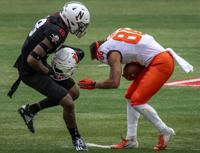
Nebraska safety Myles Farmer (left) is flagged for a facemask call against Illinois’ Donny Navarro (86) in the third quarter Nov. 21, 2020, at Memorial Stadium.
FRANCIS GARDLER, Journal Star file photo
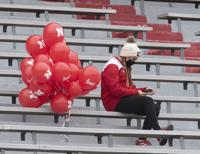
A worker waits to release balloons after the first Nebraska touchdown against Illinois on Nov. 21, 2020, at Memorial Stadium.
GWYNETH ROBERTS, Journal Star file photo
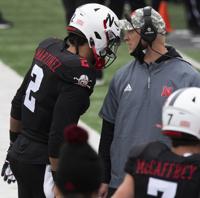
Nebraska coach Scott Frost talks with junior quarterback Adrian Martinez (2) on the sideline in the third quarter against Illinois on Nov. 21, 2020, at Memorial Stadium.
FRANCIS GARDLER, Journal Star file photo
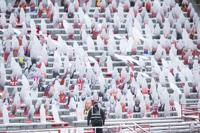
A security guard watches the field among snow-covered cardboard cutouts before a Nebraska-Minnesota football game on Dec. 12, 2020, at Memorial Stadium.
KENNETH FERRIERA, Journal Star file photo

Nebraska family members look for their seats before the Huskers host Minnesota on Dec. 12, 2020, at Memorial Stadium.
KENNETH FERRIERA, Journal Star file photo

Nebraska tight end Austin Allen (second right) celebrates his second-quarter TD with teammates against Minnesota on Dec. 12, 2020, at Memorial Stadium.
FRANCIS GARDLER, Journal Star file photo

Nebraska’s Austin Allen celebrates his first quarter touchdown catch with Brenden Jaimes and Ethan Piper against Minnesota on Dec. 12, 2020, at Memorial Stadium.
KENNETH FERRIERA, Journal Star file photo

Nebraska coach Scott Frost sends quarterback Adrian Martinez back into the game against Minnesota in the second quarter Dec. 12, 2020, at Memorial Stadium.
KENNETH FERRIERA, Journal Star file photo

Nebraska head coach Scott Frost greets Huskers captain Matt Farniok (71) during Senior Day festivities before the Minnesota game Dec. 12, 2020, at Memorial Stadium.
FRANCIS GARDLER, Journal Star file photo

Scott Frost and the Huskers run onto the field before a Dec. 12 game against Minnesota at Memorial Stadium.
KENNETH FERRIERA, Journal Star file photo
Contact the writer at pgabriel@journalstar.com or 402-473-7439. On Twitter @HuskerExtraPG.
Get local news delivered to your inbox!

Must See
-


Football
/ 5 months agoHuskers Fight Hard but Fall Short Against UCLA
LINCOLN – The Nebraska Cornhuskers gave it their all on Saturday, with standout efforts...
-
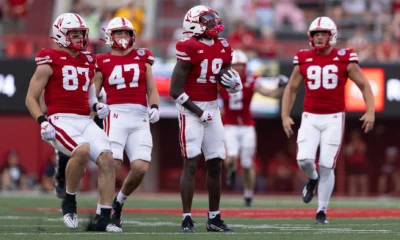

Football
/ 5 months agoGAMEDAY: Nebraska Set to Face Undefeated Indiana in Key Big Ten Showdown
Bloomington, IN – It’s Game Day, Husker Nation! Nebraska (5-1, 2-1 Big Ten) returns...
-


Football
/ 6 months agoBlackshirts Shine as Nebraska Tops Rutgers 14-7 on Homecoming
Lincoln, NE – Nebraska’s Blackshirt defense played a starring role in the Huskers’ 14-7...
By Chris

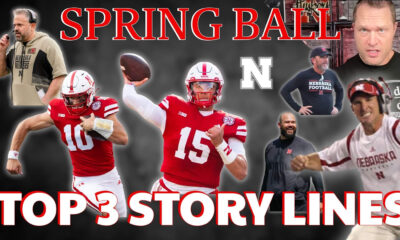











You must be logged in to post a comment Login